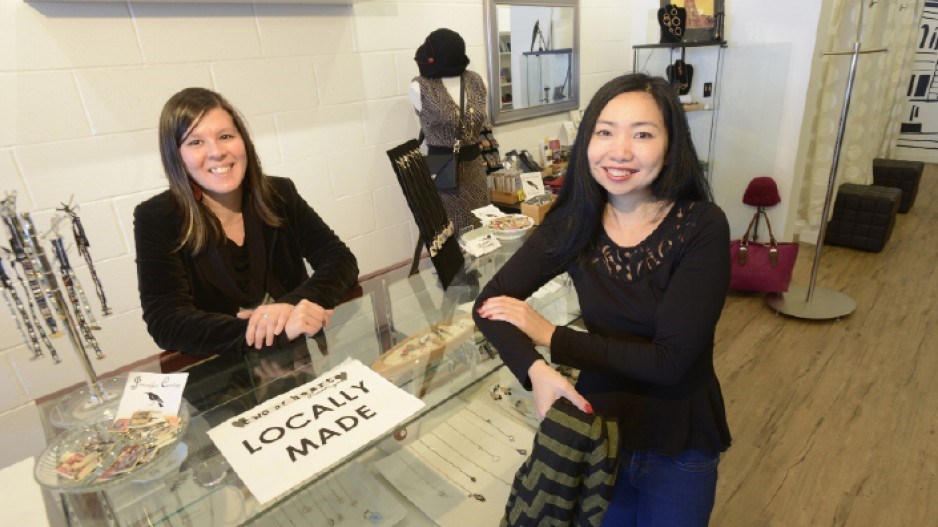Shoppers could be forgiven for assuming that nearly every stitch of clothing available for sale in Vancouver stores is made somewhere else.
But many small local designer-retailers still make all of their clothes within the city limits. While Vancouver’s clothing manufacturing industry has shrunk during the last decade, it’s still robust enough to offer different specializations and styles.
“There are some places that only do sportswear, some places only do woven dresses that are fully lined with darts and zippers,” said Tabitha Savoie, co-owner of Two of Hearts Boutique. “They have different workers too, with different skillsets.”
Larger Vancouver retailers, like Mountain Equipment Co-op (MEC), Arc’teryx, Lululemon (US:LULU) and Aritzia have moved most of their production to countries like China, Thailand and Vietnam within the past 10 years. The local industry has consequently gotten much smaller.
But for small businesses, the advantages of staying local outweigh the cost benefits of producing offshore.
“Obviously labour rates are very, very cheap offshore, and that’s one reason everybody’s moving from country to country,” Ed DesRoches, owner of Plum Clothing, told Business in Vancouver.
“All of the other expenditures that they have are very high: shipping goods, taking risks in how things are manufactured.”
Although most B.C. contractors pay their sewing staff the minimum wage, the labour costs in Canada are still much higher than overseas.
So how can a small business with only a few stores afford to eat that cost when it’s up against fast-fashion chains like H&M and Joe Fresh, which dominate with a combination of cheap offshore labour and vast economies of scale?
The difference lies in the amount of resources required to manage the complex overseas supply chain.
“Any month or week of the year, probably someone’s at a factory somewhere,” said Amy Roberts, director of sustainability for MEC.
Outdoor apparel retailers MEC and Arc’teryx both invest time, money and dedicated staff in choosing factories, setting up production and performing regular quality control inspections.
(According to MEC and Arc’teryx, neither company uses local intermediaries to source factories sight unseen, which is a common practice in the clothing manufacturing business.)
MEC also does an in-house audit, which assesses labour practices and environmental performance and determines whether the factory has the capacity to deliver the work required.
Arc’teryx pays for a third-party audit but sends its staff to its overseas factories regularly to check quality and do training.
For a small business without the resources to fly overseas to do quality control, the cost of a mistake can outweigh any cost savings, said DesRoches. He and his partner, Kate O’Brien, learned this lesson when they briefly tried manufacturing offshore.
“Once you cut [the fabric], it’s yours,” O’Brien said. “[In Vancouver] I can have my contractor call my production manager on Friday afternoon and say we’re laying out the fabric and there’s a problem with it ... we’re there in our car in 10 minutes.”
Manufacturing locally also means not having to worry as much about working conditions or paying for costly audits.
“We do our due diligence, we look for the best in the city,” DesRoches said. “We care about things like labour standards. We can’t afford to take any risks on anything that’s going on.”
Savoie said local designers can compete by offering a higher quality option and by building relationships with customers. But it’s still frustrating to see potential customers turn to fast fashion just because it’s cheaper.
“If you ever tried to make your own pair of pants or even sewn a T-shirt, you’d realize that you need to be skilled to do it,” she said.
O’Brien echoed that sentiment. She said calculating what it takes to bring the price of a pair of jeans down to $19, a price offered by some fast fashion retailers, results in a labour cost of “pennies.”
The future of Vancouver’s clothing manufacturing industry is uncertain. While Arc’teryx and MEC still have between 15% and 20% of their production here, both companies say it’s getting harder to find the next generation of garment makers.
“The challenge is that there is a declining labour pool here for sewing,” Roberts said. “If you visit many of the local factories, the sewers are not young.”




